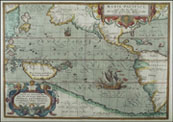|
California as an Island
For approximately 100 years, map makers showed California as an island. This error or myth persisted despite early evidence to the contrary, and in some cases for decades after published proof in 1705 that California was in fact a peninsula.
The following description, taken from the Jonathan Potter web site, explains some of the history behind this error:
One of the most notable of all cartographic errors, and one of the most identifiable, is seen on those maps which show the North American west coast with California as an island. Numerous maps exist which demonstrate this theory which was seriously held by many mapmakers for approximately one hundred years after 1622.
In 1625 Henry Briggs had produced a map which was included in the compilation of travel reports by Samuel Purchas, published in London. A legend in the lower left corner of Briggs’ map refers to a "Spanish Charte" which identifies California "to be a goodly Islande...". Although Briggs’ map is interesting as one of the earliest maps of North America alone and for its detail of the north and eastern coast lines it is for the outline of California that it is best known.
The "island" theory emanated from Spanish reports identifying the mouth of Baja and a great bay in the north which were presumed to join. The navigator Juan de Ia Fuca was responsible for some of the wildest cartographic misconceptions ever mapped. It was his report in 1592, of the large opening in the American west coast which prompted this theory and numerous others, current for nearly 200 years, suggesting the possibility of a channel linking the Pacific to the Hudson Bay and thence to Europe, i.e., the long sought north-west passage.
Briggs’ map became the standard outline, being used by Speed, Jansson, Sanson in 1650 and many others, then in 1656 Nicolas Sanson produced a new map showing a different outline (broader and with an indented north coast) which was either copied, in its entirety, or combined with the original outline on many maps throughout the rest of the century.
Strangely, before the insular theory was promulgated, California had been shown correctly as a peninsula on all maps of the world, the Americas and the Pacific. Even after 1622, many map makers did not accept the theory, or at least displayed an open mind - not by leaving the area blank, but in many atlases showing one theory on the world map and the alternative on the map of America. Even Joan Blaeu in the Atlas Maior demonstrates this - the map of America (first engraved c.1619) not being altered, whereas the world map shows the island theory. Sanson’s map of 1656 is the first to concentrate on the California / New Mexico region. During the next decades maps, showing the area in isolation, are found in sea atlases by Doncker, Van Loon, Goos, and others, and in many land atlases by Sanson, Morden, Mallet, Du Val, Coronelli, de Fer etc. In addition to maps of California the collector of island-theory maps should look at maps of North America, the Americas, the Pacific and the world - all of which may show differing detail or presentation.
In Holland, Germany and England maps, showing the island, continued to be engraved and published well into the eighteenth century. However, maps contesting the theory were being published in France from after 1705 when the Jesuit Missionary, Father Kino, by walking from New Mexico to the California Pacific coast, confirmed that California was indeed part of the North American mainland. However, it was not until mid-century, in 1747, that King Ferdinand VII of Spain decreed that California was not an island.
The following links provide additional information and additional maps (mostly for sale) showing the island of California:
Spotlight on Antique Maps and Charts: California as an Island, Jonathan Potter Ltd.
Mythical Geography: California as an Island, The Philadelphia Print Shop
Maps of California as an Island, Fair Winds Antique Maps
Speed, 1626
(detail from map of North America) showing original north coast

|
Goos, 1666
showing indented north coast

|
Coronelli, 1696
(detail from map of Pacific Ocean)

|
|
